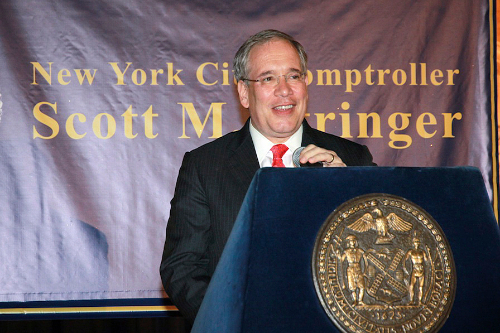
Office of the Comptroller
Comptroller Stringer gave his own office a C.
The report released Wednesday by city Comptroller Scott Stringer on the city’s record in hiring minority- and women-owned business for city contracts made headlines for the D+ it gave the de Blasio administration overall—reflecting progress over the past year that was, in the comptroller’s view, unsatisfactory. Stringer’s report gave his own office a C, and did note that eight city agencies improved from 2014 while four scored lower.
City Hall argued that the comptroller’s assessment, which looks at contract spending, doesn’t truly reflect de Blasio’s record because it includes ongoing contracts awarded during the Bloomberg years. The administration wants to be judged instead on the contract awards it makes each year. The difference in methods makes a big difference in the math: By Stringer’s measure, the administration directed $725 million to M/WBEs in fiscal 2015, but according to de Blasio’s metric the number is $1.6 billion.
Beneath the dollar signs and letter grades is a potentially more important discussion about how this spending is tracked in the first place—namely, how subcontractors, who do a large share of the city’s actual contract work, are tracked. As Adam Wisnieski pointed out in our 2013 investigation of M/WBE compliance, the city’s inability to accurately measure M/WBE participation among subcontractors has impeded efforts to hold mayors and agencies to the inclusion standards set forth in city law.
Stringer’s report reads:
[W]hile this year’s grades include subcontractor data inputted by prime contractors into PIP, many agencies have done little to hold primes accountable and, as a result, do not have any subcontractor information in PIP or Checkbook NYC. … Nineteen agencies provided no information about subcontractor spending (see Table B), with the remaining 13 providing spending information or having no eligible M/WBE subcontractor spending to report. However, it is not possible to determine whether the information provided represents all subcontractor spending or only a portion, since the total number of subcontractors that each prime contractor employs is not currently publicly available.
City Hall notes that the PIP (that stands for Payee-Informational-Portal) reporting requirement has only been in effect since March 2013, and therefore some of those pre-existing contracts aren’t covered. The administration is now doing monthly trainings for agencies on how to comply, and says the number of payments reported to PIP has increased 171 since the end of fiscal 2014.
As that process plays out and compliance improves, there’ll be more data for Stringer and others to look at. Whether that will reflect better or worse performance than we see now remains to be seen.








